Page 87 of 276
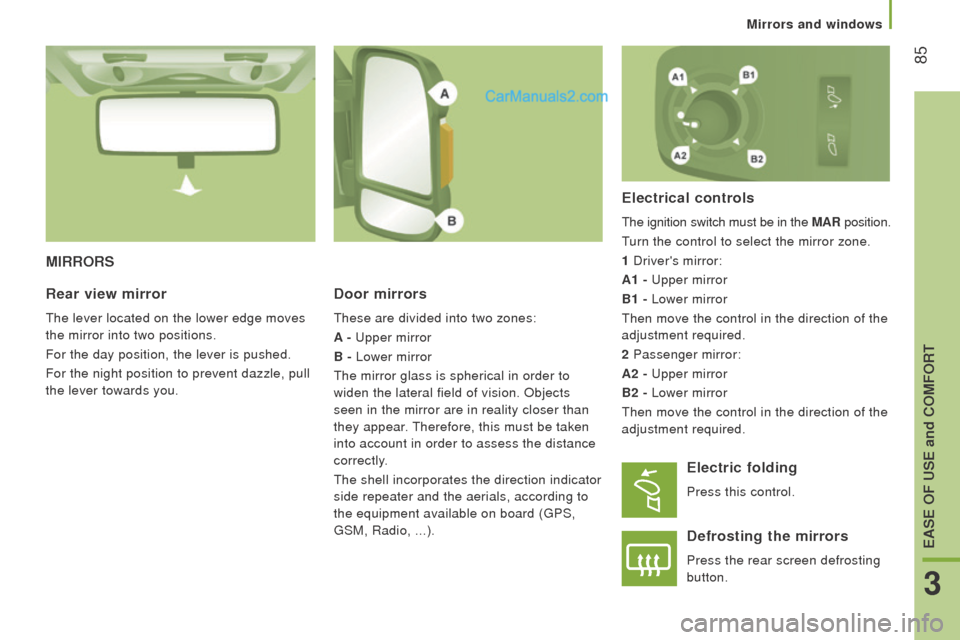
85
MIrrorS
door mirrors
these are divided into two zones:
A -
upper mirror
B -
Lower mirror
the mirror glass is spherical in order to
widen the lateral field of vision. Objects
seen in the mirror are in reality closer than
they appear.
therefore, this must be taken
into account in order to assess the distance
correctly.
the shell incorporates the direction indicator
side repeater and the aerials, according to
the equipment available on board (
gPS,
gSM, Radio, ...).
Electrical controls
the ignition switch must be in the MAr position.
turn the control to select the mirror zone.
1 Driver's mirror:
A1 -
upper mirror
B1 -
Lower mirror
then move the control in the direction of the
adjustment required.
2 Passenger mirror:
A2 -
upper mirror
B2 -
Lower mirror
then move the control in the direction of the
adjustment required.
rear view mirror
the lever located on the lower edge moves
the mirror into two positions.
For the day position, the lever is pushed.
For the night position to prevent dazzle, pull
the lever towards you.
Electric folding
Press this control.
defrosting the mirrors
Press the rear screen defrosting
button.
3
EASE oF uSE and coMFort
Mirrors and windows
Page 88 of 276
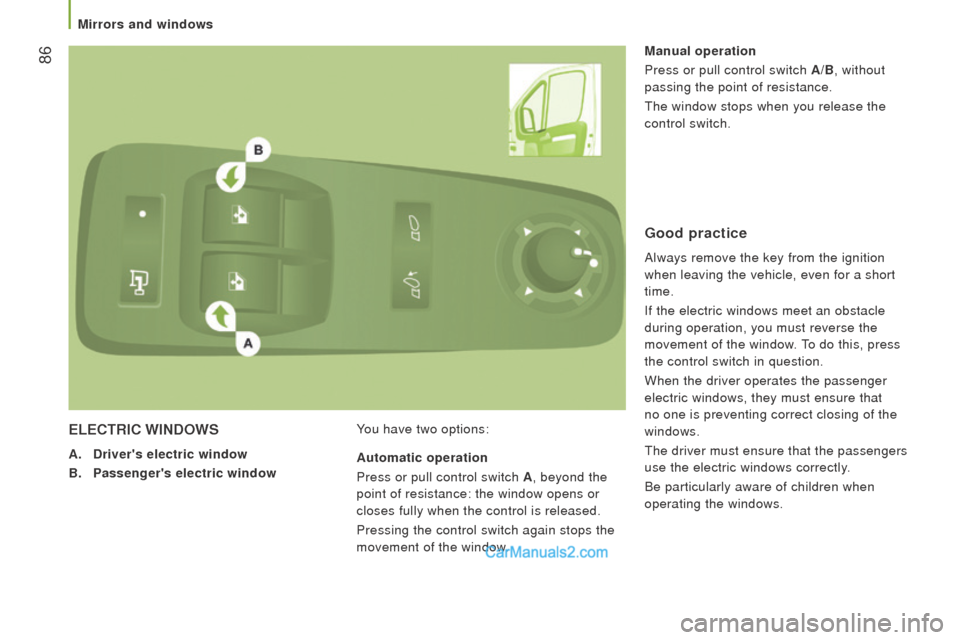
86
ELEctrIc WIndoWS
A. driver's electric window
B.
Passenger's electric window You have two options: Manual operation
Press or pull control switch
A/B, without
passing the point of resistance.
the window stops when you release the
control switch.
Automatic operation
Press or pull control switch A , beyond the
point of resistance: the window opens or
closes fully when the control is released.
Pressing the control switch again stops the
movement of the window.
Good practice
Always remove the key from the ignition
when leaving the vehicle, even for a short
time.
If the electric windows meet an obstacle
during operation, you must reverse the
movement of the window.
to do this, press
the control switch in question.
When the driver operates the passenger
electric windows, they must ensure that
no one is preventing correct closing of the
windows.
the driver must ensure that the passengers
use the electric windows correctly.
Be particularly aware of children when
operating the windows.
Mirrors and windows
Page 89 of 276
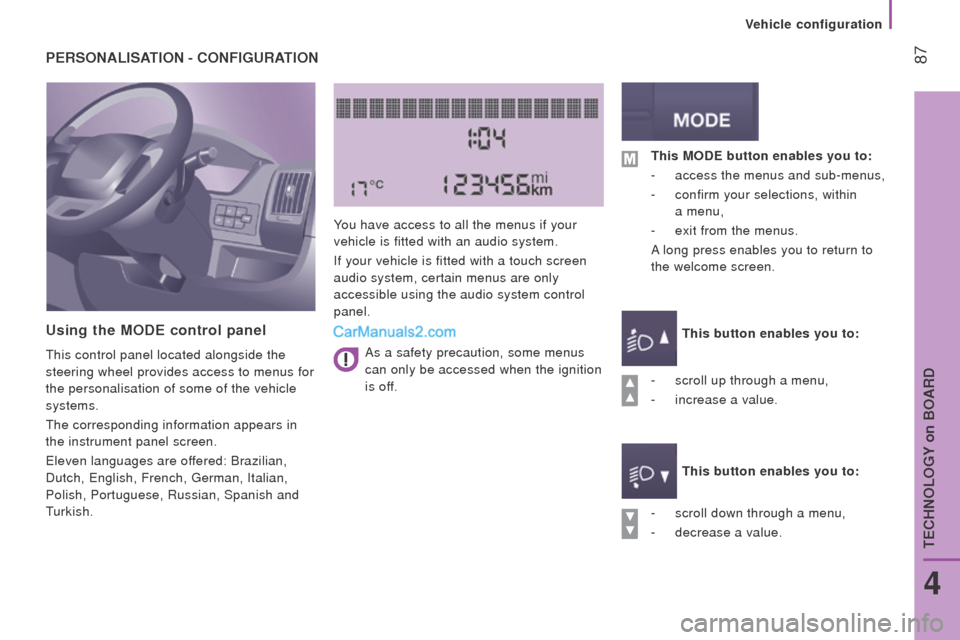
87PErSonALISAtIon - conFIGurAtIon
using the ModE control panel
this control panel located alongside the
steering wheel provides access to menus for
the personalisation of some of the vehicle
systems.
the corresponding information appears in
the instrument panel screen.
eleven languages are of
fered: Brazilian,
Dutch,
english, French, german, Italian,
Polish, Portuguese, Russian, Spanish and
turkish. You have access to all the menus if your
vehicle is fitted with an audio system.
If your vehicle is fitted with a touch screen
audio system, certain menus are only
accessible using the audio system control
panel.
-
scroll down through a menu,
-
decrease a value.
this ModE button enables you to:
-
access the menus and sub-menus,
-
confirm your selections, within
a
menu,
-
exit from the menus.
A long press enables you to return to
the welcome screen.
this button enables you to:
this button enables you to:
-
scroll up through a menu,
-
increase a value.
As a safety precaution, some menus
can only be accessed when the ignition
is off.
4
teCHNOLOgY on BOARD
Vehicle configuration
Page 92 of 276
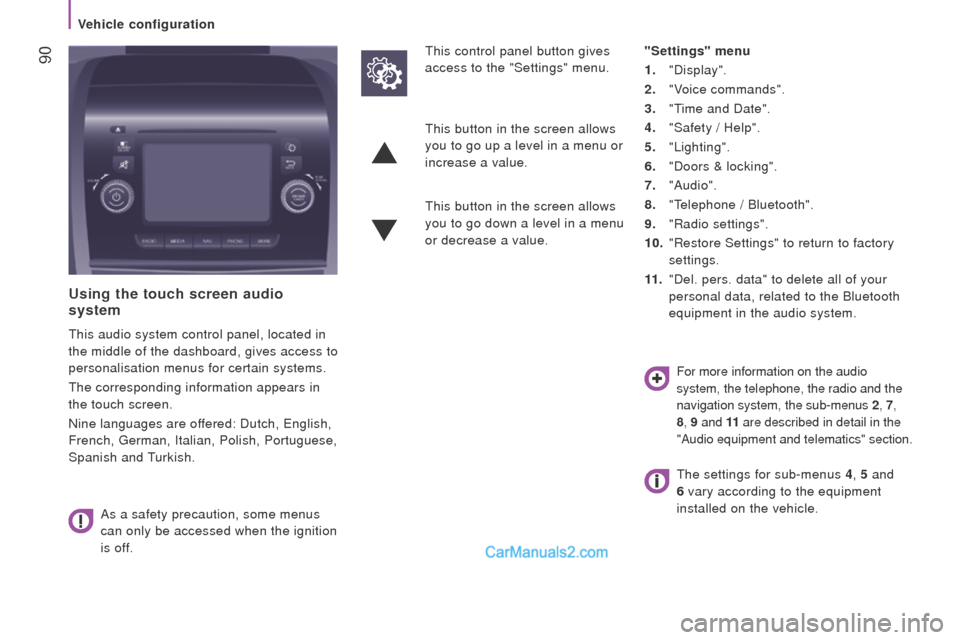
90
using the touch screen audio
system
this audio system control panel, located in
the middle of the dashboard, gives access to
personalisation menus for certain systems.
the corresponding information appears in
the touch screen.
Nine languages are offered: Dutch,
english,
French,
german, Italian, Polish, Portuguese,
Spanish and
turkish.
As a safety precaution, some menus
can only be accessed when the ignition
is off.
this control panel button gives
access to the "Settings" menu. "Settings" menu
1.
"Display".
2.
"Voice commands".
3.
"time and Date".
4.
"Safety / Help".
5.
"Lighting".
6.
"Doors & locking".
7.
"Audio".
8.
"telephone / Bluetooth".
9.
"Radio settings".
10.
"Restore Settings" to return to factory
settings.
11
.
"Del. pers. data" to delete all of your
personal data, related to the Bluetooth
equipment in the audio system.
this button in the screen allows
you to go up a level in a menu or
increase a value.
this button in the screen allows
you to go down a level in a menu
or decrease a value.
For more information on the audio
system, the telephone, the radio and the
navigation system, the sub-menus
2
, 7,
8, 9 and 11 are described in detail in the
"Audio equipment and telematics" section.
the settings for sub-menus 4 , 5 and
6 vary according to the equipment
installed on the vehicle.
Vehicle configuration
Page 94 of 276
92
the trIP button, located at the end of the
wiper control stalk, gives access to the
following information:
-
range
this indicates the distance that can still
be travelled with the fuel remaining in
the tank on the basis of the average
consumption over the last few miles
(kilometres) travelled. - Average
speed A
this is the average speed calculated
since the last trip computer zero reset
(with the ignition on).
-
trip duration A
this indicates the total time since the
last trip recorder zero reset.
-
distance A
this indicates the distance travelled
since the last trip computer zero reset.
-
Average fuel consumption
A
this is the average quantity of fuel
consumed since the last trip computer
zero reset.
-
current fuel consumption
A
this is the average quantity of fuel
consumed during the last few seconds.
trIP coMPutEr
If tRIP B is activated in the ModE menu:
-
Distance B
-
Average fuel consumption B
-
Average speed B
-
t
rip duration B
Vehicle data
Page 100 of 276
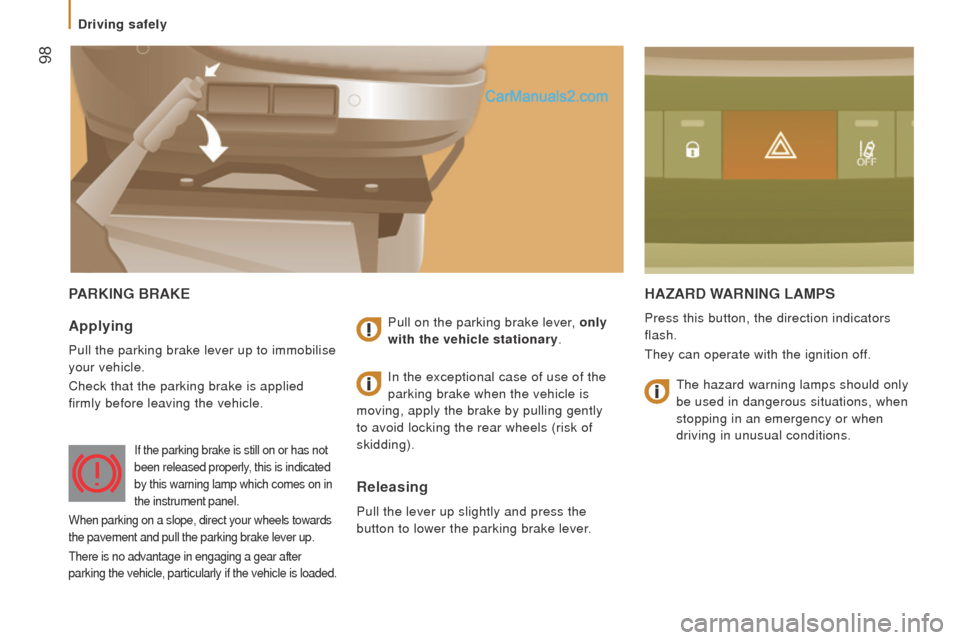
98
PArKInG BrAKEHAzArd WArnInG LAMPS
Press this button, the direction indicators
flash.
they can operate with the ignition of
f.Applying
Pull the parking brake lever up to immobilise
your vehicle.
Check that the parking brake is applied
firmly before leaving the vehicle. Pull on the parking brake lever, only
with the vehicle stationary.
releasing
Pull the lever up slightly and press the
button to lower the parking brake lever.In the exceptional case of use of the
parking brake when the vehicle is
moving, apply the brake by pulling gently
to avoid locking the rear wheels (risk of
skidding).
If the parking brake is still on or has not
been released properly, this is indicated
by this warning lamp which comes on in
the instrument panel.
When parking on a slope, direct your wheels towards
the pavement and pull the parking brake lever up.
there is no advantage in engaging a gear after
parking the vehicle, particularly if the vehicle is loaded.
the hazard warning lamps should only
be used in dangerous situations, when
stopping in an emergency or when
driving in unusual conditions.
Driving safely
Page 104 of 276
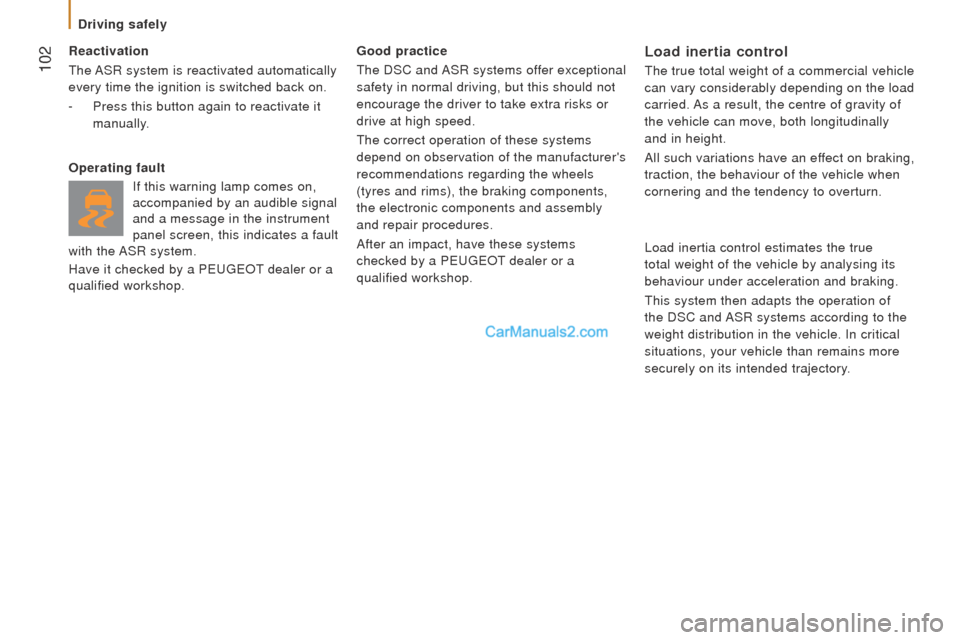
102
reactivation
the
ASR system is reactivated automatically
every time the ignition is switched back on.
-
Press this button again to reactivate it
manually
.
operating faultIf this warning lamp comes on,
accompanied by an audible signal
and a message in the instrument
panel screen, this indicates a fault
with the ASR system.
Have it checked by a P
eugeOt dealer or a
qualified workshop. Good practice
the DSC and
ASR systems offer exceptional
safety in normal driving, but this should not
encourage the driver to take extra risks or
drive at high speed.
the correct operation of these systems
depend on observation of the manufacturer's
recommendations regarding the wheels
(tyres and rims), the braking components,
the electronic components and assembly
and repair procedures.
After an impact, have these systems
checked by a P
eugeOt dealer or a
qualified workshop.
Load inertia control
the true total weight of a commercial vehicle
can vary considerably depending on the load
carried.
As a result, the centre of gravity of
the vehicle can move, both longitudinally
and in height.
All such variations have an effect on braking,
traction, the behaviour of the vehicle when
cornering and the tendency to overturn.
Load inertia control estimates the true
total weight of the vehicle by analysing its
behaviour under acceleration and braking.
this system then adapts the operation of
the DSC and ASR systems according to the
weight distribution in the vehicle. In critical
situations, your vehicle than remains more
securely on its intended trajectory.
Driving safely
Page 107 of 276
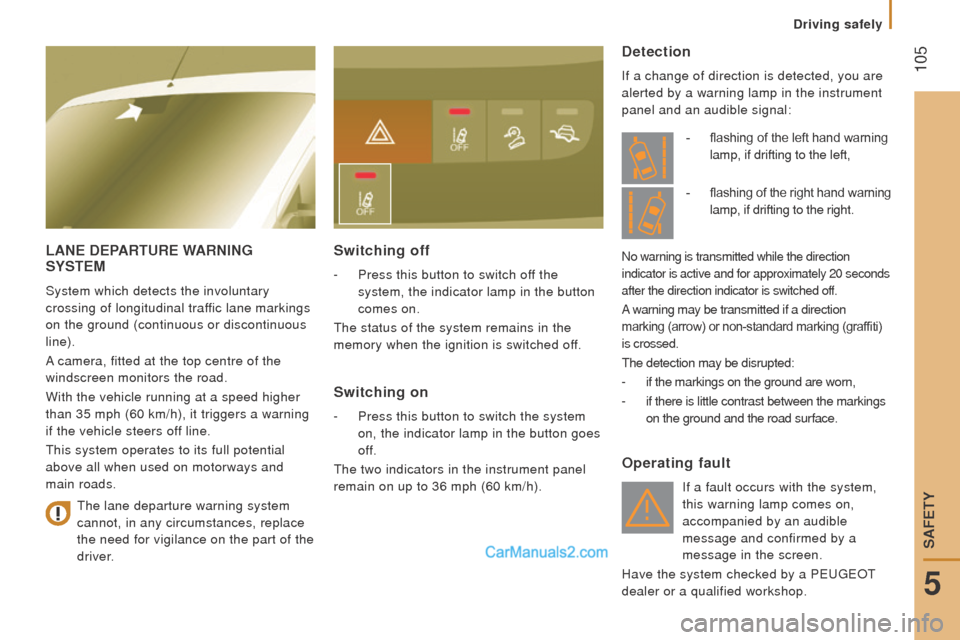
105
LAnE dEPArturE WArnInG SYStEM
System which detects the involuntary
crossing of longitudinal traffic lane markings
on the ground (continuous or discontinuous
line).
A camera, fitted at the top centre of the
windscreen monitors the road.
With the vehicle running at a speed higher
than 35 mph (60 km/h), it triggers a warning
if the vehicle steers off line.
this system operates to its full potential
above all when used on motorways and
main roads.
Switching off
- Press this button to switch off the
system, the indicator lamp in the button
comes on.
the status of the system remains in the
memory when the ignition is switched off.
Switching on
- Press this button to switch the system
on, the indicator lamp in the button goes
off.
the two indicators in the instrument panel
remain on up to 36 mph (60 km/h).
detection
If a change of direction is detected, you are
alerted by a warning lamp in the instrument
panel and an audible signal:
operating fault
If a fault occurs with the system,
this warning lamp comes on,
accompanied by an audible
message and confirmed by a
message in the screen.
Have the system checked by a P
eugeOt
dealer or a qualified workshop.
the lane departure warning system
cannot, in any circumstances, replace
the need for vigilance on the part of the
driver. -
flashing of the left hand warning
lamp, if drifting to the left,
No warning is transmitted while the direction
indicator is active and for approximately 20
seconds
after the direction indicator is switched off.
A warning may be transmitted if a direction
marking (arrow) or non-standard marking (graffiti)
is crossed.
the detection may be disrupted:
-
if the markings on the ground are worn,
-
if there is little contrast between the markings
on the ground and the road surface. -
flashing of
the right hand warning
lamp, if drifting to the right.
5
Driving safely
SAFetY